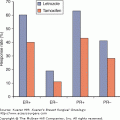Breast cancer survivors number more than 2,000,000 in the United States alone.1 Improvements in screening technology, increased uptake of screening, and advances in adjuvant therapy2 as well as the aging of the population are bound to lead to even greater numbers of breast cancer survivors over time. The Institute of Medicine report entitled From Cancer Patient to Cancer Survivor: Lost in Transition reported on the health, psychosocial, family, employment, and financial needs of survivors of cancer and provided recommendations for improving the quality of care and health outcomes of cancer survivors.3 Follow-up of the breast cancer survivor is one important aspect of survivorship care.
As described in preceding chapters, multimodality therapy of breast cancer is associated with acute side effects such as postoperative pain, skin toxicity from radiation, fatigue, alopecia, and anemia related to chemotherapy. As people recover from these effects, new issues requiring attention may arise (Table 98-1). The long-term and late effects of cancer and its treatment are addressed in other chapters of this section.
| Issues related to physical health after breast cancer and its treatment |
| Fatigue |
| Premature menopause |
| Bone health |
| Side effects of endocrine therapy |
| Sexual health |
| Cardiac dysfunction |
| Risk of secondary cancers |
| Pregnancy after breast cancer |
| Lymphedema |
| Disruption of cognitive function |
| Psychological and social aspects of survivorship |
| Concerns about recurrence |
| Impact of cancer on the family |
| Sexual health |
| Impact of cancer on employment and financial health |
Physicians who care for survivors of breast cancer—including surgeons, medical oncologists, radiation oncologists, primary care physicians, gynecologists, and mental health professionals— have the opportunity to address the concerns of breast cancer survivors and to intervene to improve functional status and quality of life. In addition, physical therapists, dieticians, sexual health therapists, and social work professionals provide care to survivors as described in earlier chapters. Coordinating the care of breast cancer survivors among multiple providers can itself become a challenge for patients. In addition, patients are often not clear about the purpose of follow-up care.4 Finally, the medical costs of breast cancer follow-up are substantial.5,6 In one study of 391 women, the average estimated costs per year per patient were $1800.6
There are several goals of scheduled follow-up care in breast cancer survivors7: detection and management of second primary breast cancers and locoregional breast cancer recurrences, detection and management of late and long-term effects of treatment, management of adjuvant endocrine therapy, recognition of genetic cancer syndromes, and promotion of healthy behaviors. Provision of information to survivors on the treatments they received and what they should expect during the months and years after treatment is important to achieve and preserve optimal health in survivors and their families.
There is no evidence that follow-up with cancer care providers improves the likelihood or duration of survival in patients after breast cancer. In addition, specialized cancer care does not appear to decrease the risk of catastrophic events such as spinal cord compression, pathologic fractures, hypercalcemia, or decline in functional status attributable to cancer recurrence.8 In contrast, prompt evaluation of symptoms that may reflect metastatic recurrence is critical to avoid and treat such events and other symptoms of metastatic disease. The risk of recurrent disease even 5 years after completion of therapy ranges from 2% (for women with stage I disease) to nearly 15% (for women with stage III disease) over the following 5 years.9 The evaluation of women suspected of having metastatic recurrence is described earlier in the textbook.
Primary care physicians may assume the care of breast cancer patients if familiar with the issues faced by breast cancer survivors and if experienced in examining women after breast surgery and radiation therapy.8 In a randomized study of primary care follow-up compared with cancer specialist follow-up, 968 (58%) of 1760 patients invited to participate agreed to be randomized. Enrolled patients were followed by either their family physician, who was provided a 1-page information sheet about recommended follow-up care, or their treating cancer providers. There were no differences in the occurrence or detection of serious clinical events between the 2 groups of patients. Prompt referral of patients with metastases will allow the newly diagnosed patient with stage IV disease to receive optimal management of her disease in a timely fashion.
Shared follow-up between cancer specialists and primary care physicians represents another model for the care of an increasing number of cancer survivors. Patients cared for in a shared care model see both their primary care physicians and their oncologists in a well-coordinated schedule of follow-up. This model requires frequent and high-quality communication between providers and clear expectations about the role of each provider.10 Shared care with a primary care provider increases the likelihood that appropriate screening for other medical problems, such as hyperlipidemia, and preventive services, such as influenza vaccination.11 Nurse practitioners familiar with the principles of follow-up may provide care to well patients after completion of breast cancer treatment.12
Recommendations for follow-up in breast cancer include a history and physical, breast imaging, appropriate referral for genetic counseling, and regular pelvic examinations. Patients should also be informed about symptoms of recurrence. Guideline-concordant follow-up care has been shown to minimize costs of care while maximizing health outcomes, including quality of life.13,14 Recommended follow-up of women who have completed multimodality therapy of breast cancer is summarized in Table 98-2.
| History and physical examination | Every 3 to 6 months for the first 3 years of follow-up; every 6 months for years 4 and 5; annually after 5 years Visits should include provision of information about symptoms of recurrence Women should be counseled to perform breast self-examination monthly, although there is no clear evidence that breast self-examination improves outcome |
| Mammography | Annually Women who had breast-conserving therapy should have a mammogram of the treated breast approximately 6 months after completion of radiation therapy |
| Referral for genetic counseling | Indicated for patients with a compelling personal or family history (see also Chapter 8) |
| Pelvic examination | Regular gynecologic care is recommended. Women on tamoxifen should be told to report any postmenopausal bleeding |
| Monitoring of bone health | Indicated for women who are at risk of loss of bone mineral density (for example, women who have premature menopause due to chemotherapy or women on aromatase inhibitors) |
| Lifestyle counseling | Patients should be informed of screening recommendations for other cancers, importance of strategies for weight loss, smoking cessation resources |
| Referral to appropriate specialists | Patients should be offered referral to specialty services, such as physical therapy for the management of lymphedema, registered dieticians, supportive psychotherapists, sex therapists, financial counselors, and employment attorneys |
A careful history for symptoms of recurrence or of long-term and late effects of treatment is important in caring for the cancer survivor.15 The recommended frequency of a medical history is every 3 to 6 months for the first 3 years after completion of multimodality therapy. Thereafter, the frequency of follow-up visits can decrease to every 6 months in the fourth and fifth years followed by annual visits thereafter.16,17 Symptom assessment should determine the presence of symptoms that may suggest metastatic recurrence of cancer or the development of long-term adverse effects of treatment, such as cardiomyopathy related to anthracycline use. Neurologic symptoms or deficits should similarly prompt further investigation of possible distant metastases, although neuropathy is a known side effect of some chemotherapy agents, such as the taxanes. Any bone pain should be thoroughly investigated and evaluated with plain films and bone scan to evaluate for metastatic disease. It is important to distinguish between bone pain and joint symptoms that may occur in patients experiencing menopause or treated with adjuvant endocrine therapy to avoid overuse of imaging studies. Postmenopausal women on tamoxifen should be asked if they have had any vaginal bleeding, as such bleeding may indicate the presence of endometrial cancer, an uncommon but important adverse effect of tamoxifen.
Patients who are on tamoxifen should not take medications that inhibit CYP2D6, such as the selective serotonin receptor antagonists fluoxetine and paroxetine, because these drugs inhibit conversion of tamoxifen to its active metabolite, endoxifen, and may reduce the effectiveness of tamoxifen.18
A physical examination should be performed during follow-up visits.16 A careful examination of bilateral nodal basins, including cervical, supraclavicular, and axillary nodes, should be performed at every encounter, in addition to examination of the breasts in the upright and supine position for changing asymmetry, skin changes, new dominant masses, nodularity, or skin thickening. Cardiovascular and pulmonary examinations should be performed to evaluate for the presence of pleural or pericardial effusions or cardiac dysfunction. An examination of the abdomen should be done to evaluate for evidence of hepatomegaly or right upper quadrant tenderness. In the patient with upper extremity lymphedema, early referral to an experienced physical therapist may reduce the severity of long-term lymphedema and decrease the functional impairment associated with lymphedema.
Stay updated, free articles. Join our Telegram channel

Full access? Get Clinical Tree







